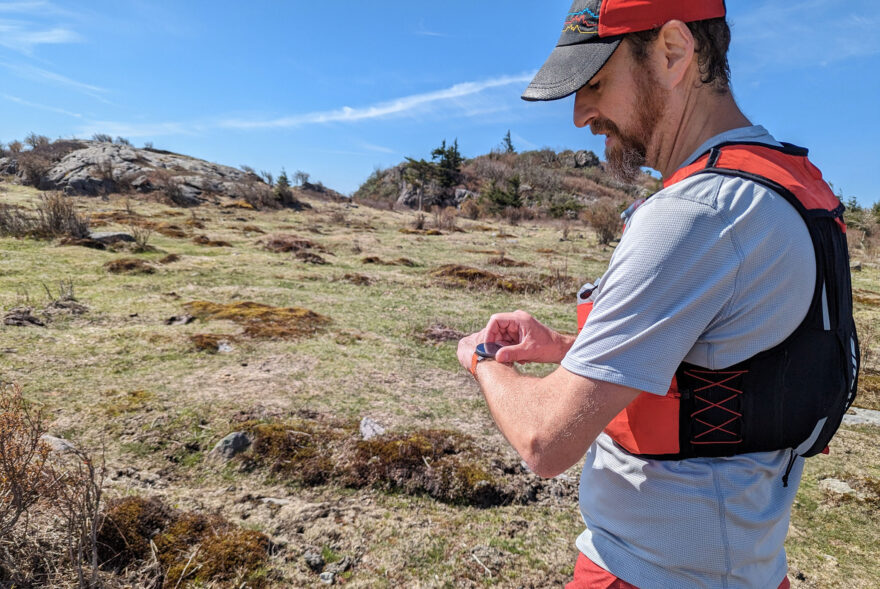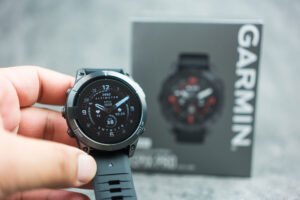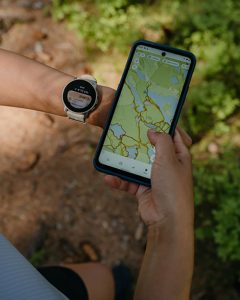
Ryan Tipps navigates using a Suunto Vertical during an ultramarathon in Virginia. (Image by Bay Roan Creative)
Most endurance athletes wear some kind of sport watch on their wrist, something that can track a wide variety of activities. I think a sport watch is one of the best tools you can invest in because of how it helps you put your training distances, heart rate, and sleep patterns into perspective (just don’t become too much a slave to the numbers!). As a trail and ultra runner for the past several years, I went through a handful of watches from multiple brands and settled on the things I want the most in a wearable: Let’s call them my five non-negotiables.
Your non-negotiables are almost certainly going to be different than mine. They can include things such as battery life, GPS accuracy, style, navigation features, screen display technology, customer support, smartwatch functions, and so much more. And the things you may care about should go beyond the watch itself — think ecosystem. How well does your watch’s app play with other platforms (such as Strava, TrainingPeaks, or MyFitnessPal)? How easy is the app to use, and does it give you all the data you want or need?
These are all questions that I hope everyone asks themselves before shopping for a sport watch.
I’ve had my list in the back of my mind for about a year now, and whenever I see a new sport watch release, I quietly analyze how many of these points that new wearable hits. Here are my five I always look for:
1. GPS Accuracy
I have fallen in love with nice crisp lines during my training runs, whether I’m hitting a paved greenway in town or twisting through the remote single-track. I’ve found myself doing a lot more out-and-back runs, too, so that I can see how wonderfully my tracks lay on top of each other. I’ll be honest that, as an ultrarunner, my runs are measured in hours and miles, not seconds and feet, so extreme GPS precision isn’t vital to success in my sport. But it is something I fully appreciate in a sport watch.
And it’s very satisfying to run a race that officials have measured using a bike wheel at 27.5 miles to then see your watch reading 27.47 miles at the finish line!
2. Build Quality and Design
These could reasonably be two separate elements, but because I think they complement each other so well, I’m combining them here. My usual running routes are in old growth forests, where thick trees hug the trails closely and underfoot are numerous loose rocks and ankle-biting roots. Falling from time to time is inevitable — and I still have the scars from some of those falls. My watch bangs into trees and bounces hard off of rocks on a regular basis. Sapphire glass is a must, and the strap has to be durable enough not to pop off (I’ve almost lost watches while kayaking because of poor pin connections). I like titanium builds, but one of my favorite watches ever was steel. Either way, I don’t care about scratches on the bezel, but I do care about keeping the components inside intact and functional.
Accompanying that is being able to access everything well. As I get older, a 1.3-inch to 1.4-inch screen is important, but my wrists are at a size where I have to be highly selective when going above a 50 mm case or below 42 mm. Sometimes sizes outside that window work, but oftentimes they do not. I also am not a fan of overly tactical styling on a watch, but I want good waterproofing and for the buttons to be durable enough to last many, many years.
3. Offline Syncing
It’s rare that the start and finish line of an ultramarathon in my region has cellular service. Also unlikely is having a good signal on a remote camping trip or extended hike. My sport watch’s app needs to function nonetheless. I want to have access to the metrics and other details from my activity even when offline. Full stop.
This is 2024, and it’s stunning that there are products out there that still can’t — or won’t — do that.
4. In-App Navigation
My current watch has offline maps, but I’ll admit that I don’t use them that much — and certainly not enough to call them a “non-negotiable” in a device. However, having robust mapping features in the app is very important to me. When visiting new areas, I like to plan ahead of my runs and have heat maps displayed to give me an idea of popular places to go. This is especially vital on trails to see which ones are runnable and safe.
I also like to be able to see all of the trails I’ve been on after a run or hike, and more urban-centric platforms such as Google Maps fall well short of competitors like Mapbox. Google Maps displays only a fraction of available trails and is very poor about showing forest service roads. More detail when off-grid is so vital for athlete well-being, and as someone who has been involved in wilderness search and rescue for almost two decades, I’ve seen how hazardous inadequate mapping can be.
5. Enthusiastic Culture
There are a lot of ways to interpret this, but I enjoy supporting a brand that supports athletes (and especially trail runners). I want manufacturers to use social media to encourage their customers to push themselves further and higher than they expected, and to support sustainability to help protect the natural world around us.
Maybe I’m just easy prey for marketers, but I like a brand that works to create a community in sport. It takes listening, responding and nurturing to succeed in that space, but the sport watch manufacturers who can achieve that are all the stronger for it.
Ryan Tipps is Managing Editor for ActionHub. He lives along the Blue Ridge Mountains, is an avid hiker, backpacker and trail runner and has been a part of the wilderness search and rescue community since 2005.
 Your Privacy Choices
Your Privacy Choices


